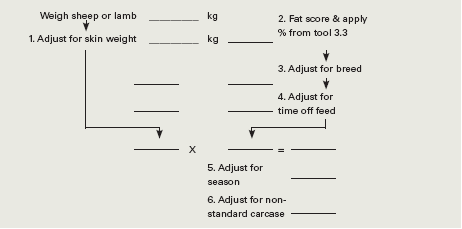 |
 |
Weigh and fat score lambs
to monitor growth rate
and condition and use the
information to better manage
the production system and
meet target specifications.
|
 |
Use dressing percentage to
convert live animal weight into
carcase weight of each sale
consignment.
|
 |
Use MSA guidelines for lamb
and sheepmeat to improve
product eating quality.
|
 |
Understand management factors affecting skin values. |
|
 |
Key decisions, critical actions and benchmarks
Weigh and/or fat score lambs
Weighing all or a representative 20%
sub-sample of lambs at weaning is
recommended. Lambs should be weighed
after 2-3h off feed for an accurate
assessment. Make adjustments for wet
or damp sheep and wool length. After
weighing, draft lambs into liveweight
categories and then use fat scoring to
assess the range in fatness.
Fat scoring of sale lambs (see tool 3.3) is
an important pre-sale procedure when
targeting a market (see Carcase fat score
descriptions table in Procedure 3.1). The
fat scores are based on the live animal
tissue thickness (both fat and lean tissue)
at the GR site (110mm from the carcase
midline over the 12th rib). A practical
option is to draft lambs into liveweight
categories then fat score a 20% sub-sample
of the animals. This is used to
estimate the amount of fat cover on the
carcase and fat scores or MSA processing
classes from 1 (leanest) to 5 (fattest).
Predict carcass weight from dressing percentage
Australian lambs generally have a standard dressing percentage of 45-49% hot weight, 2‑3 hours off feed.
Use dressing percentage to convert live animal weight into carcase weight (as per figure 3.3).
Figure 3.3 Converting live weight to carcase weight

Factors affecting dressing percentage include:
- Breed type - at the same fatness, more muscled animals dress higher; Merinos tend to dress lower. Border Leicester/ Merino and Merino lambs will generally dress 1.5% to 3.5% less than second cross lambs.
- Age - older animals have a lower dressing percentage (suckers > carryover lamb > ewe mutton). Tool 3.3 tables these differences.
- Fat score - higher fat score animals have a higher dressing percentage (see tool 3.3)
- Time off feed and water prior to weighing - increased time held off-feed increases dressing percentage (see tool 3.3).
- Seasonal feed conditions - low digestibility pasture will reduce dressing percentage by as much as 3%
- Sex – wether lambs dress higher than ewe lambs
- Skin weight: if wool is dry make no adjustment for weight. If wool is wet with a 75mm wool length, it will hold 0.2-0.5kg of water.
Apply Meat Standards Australia™ (MSA) sheepmeat guidelines
Use of MSA guidelines for lamb and sheepmeat will improve the eating quality of lamb, hogget, young mutton and mutton.
Key MSA on-farm guidelines include:
- First and second cross lambs gain at least 100g/day weight for the two weeks before consignment and sale.
- Merino lambs gain at least 150g/day before consignment and slaughter.
- Sheep are at least fat score 2 at slaughter.
- Sheep are gaining weight for at least 2 weeks before consignment for slaughter.
Additional guidelines and further information on the MSA production system can be found in tool 3.5 and tool 3.6 presents the MSA processing guide.
Livestock Quality Systems
Livestock Quality Systems (LQS) provides certification and verification systems that instil confidence in on-farm food safety practices.
LQS consists of four major programs:
- Livestock Production Assurance (LPA) – on-farm food safety certification program designed to help the red meat industry strengthen the food safety systems currently in place.
- National Vendor Declarations (NVD) – the key tool used by sheep producers to declare valuable information about the food safety status of the livestock being sold in Australia.
- Electronic Declaration Program – download software programs that provide electronic versions of the LPA NVD/Waybill.
- Livestock Fodder Declarations – obtained from the supplier of livestock fodder at purchase to indicate the chemicals used.
The National Livestock Identification Scheme (NLIS) for Sheep and Goats
Throughout Australia, producers are required to know where the sheep and goats under their management have come from and where they are going.
As of 1 Jan 2011
(1) All sheep and managed goats must
be identified with an approved NLIS ear
tag before leaving their property – be
they destined for a saleyard, abattoir,
live export, sale over-the-hooks (OTH)
or another property with a different
Property Identification Code (PIC).
(2) The NLIS ear tag must be imprinted
with the owner’s PIC (in all states but
WA) or a registered brand (in WA only).
(3) All transported sheep and goats,
must be accompanied by accurate and
fully completed movement documents,
generally a Livestock Production
Assurance National Vendor Declaration
and Waybill (LPA NVD/Waybill).
In addition, a mob-based movement
must also be recorded in the NLIS
database. The person responsible for the
livestock at the destination property will
need to record movements of mobs of
sheep and goats between the properties
with different PICs on the NLIS
database.
For further information refer to National
Livestock Identification System (NLIS) website: https://www.nlis.com.au/
The National Residue Survey
The National Residue Survey is an
Australian Government program that
monitors agricultural products and
meat producing animals for residues of
agricultural and veterinary chemicals,
as well as some environmental and
industrial contaminants.
The general purpose of residue
monitoring is to confirm that residues
in products are within internationally
accepted limits and to alert responsible
authorities when limits are exceeded so
that corrective action can be taken, and
affected product removed from the food
chain.
The survey is designed to confirm
Australia’s status as a producer of clean
meat. Abide by withholding periods for
a range of chemicals to avoid residues in
sheep meat.
|